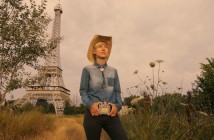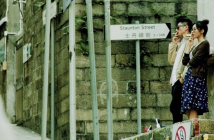Cast: Jan Nowicki, Tadeusz Kondrat, Irena Orska
Director: Wojciech Has
Country: Poland
Genre: Drama | Fantasy
Editor’s Notes: The following review is part of our coverage for Martin Scorsese Presents: Masterpieces of Polish Cinema which runs from February 5th to 16th. For more information on this film series visit filmlinc.com and follow The Film Society of Lincoln Center on Twitter @FilmLinc.
Wojciech Has’ screen adaptation of Polish Jewish writer Bruno Schulz’ 1930s stories begins with a fluid opening shot that presents a frame within a frame and efficiently establishes its interlocking themes of time, mortality, consciousness, and narrative. The camera pans across a winter-lit sky and then several trees empty of branches but covered with patches of snow. As it continues to focus on the breadth of the trees, the camera lowers, as if to bring the spectator’s eye level to the ground. But as the camera pans down, the sky and trees recede to the background and the film frame reveals a window frame from inside a train. With unassuming economy, Has goes from exterior to interior, lightness to darkness, and the actual to the imaginary. This train is, in fact, headed towards the titular sanatorium and contains the main protagonist Joseph (Jan Nowicki), whose journey in the film is less a physical one than one within the castle of his mind revolving around his experiences, memories, and dreams.
With unassuming economy, Has goes from exterior to interior, lightness to darkness, and the actual to the imaginary.
Once inside the train, the sparseness of the opening shot gives way to shots so densely populated with objects and bodies, from foreground to background, left to right, as if entering consciousness itself. The camera traverses one train car after another, and the atmosphere is one of a ghostly traveling circus. The dusky photography of the train interiors also adds to this atmosphere, complemented by the blind train conductor who looks like Death (Mieczyslaw Voit). In marked contrast to these surroundings is the ordinary-looking man seated in one of the train cars whom the train conductor rouses, Joseph, dressed in a suit as if merely on his way to the office. Like the opening shot, Has captures here Schulz’ marvelous quality of the commonplace and the extraordinary folding into each other in his stories.
 Has and cinematographer Witold Sobociński frequently used a fish-eye lens coupled with a lowered camera angle that visually distorts the relationship between bodies, objects, and space, to construct the dilapidated world of the sanatorium, beginning with its immense gates that make Joseph look like a figurine before he enters the premises. In turn, the sanatorium is an architectural ruin that operates on a different temporal rhythm and arguably stands for Joseph’s consciousness as he searches for his father Jacob (Tadeusz Kondrat) and the sanatorium’s Dr. Gotard (Gustaw Holoubek). Joseph’s initial wanderings around the place wash over the spectator with its beautiful, if grotesque, whimsicality, so that like Joseph we accept it on its own terms. Like a lush internal forest, everything is growing and dying at the same time and constantly shifting perspective, so that ‘here’ becomes ‘there’ or present becomes past with the simple elegance of a cut and the stunning baroque production design by Jerzy Skarżyński and Andrzej Płocki.
Has and cinematographer Witold Sobociński frequently used a fish-eye lens coupled with a lowered camera angle that visually distorts the relationship between bodies, objects, and space, to construct the dilapidated world of the sanatorium, beginning with its immense gates that make Joseph look like a figurine before he enters the premises. In turn, the sanatorium is an architectural ruin that operates on a different temporal rhythm and arguably stands for Joseph’s consciousness as he searches for his father Jacob (Tadeusz Kondrat) and the sanatorium’s Dr. Gotard (Gustaw Holoubek). Joseph’s initial wanderings around the place wash over the spectator with its beautiful, if grotesque, whimsicality, so that like Joseph we accept it on its own terms. Like a lush internal forest, everything is growing and dying at the same time and constantly shifting perspective, so that ‘here’ becomes ‘there’ or present becomes past with the simple elegance of a cut and the stunning baroque production design by Jerzy Skarżyński and Andrzej Płocki.
Once Joseph finds Dr. Gotard and his father, the latter explains also with simple elegance that while ‘there’ in the physical world Joseph’s father is dead, ‘here’ he is merely sleeping for an indefinite period of time. For ‘here’ time unfolds more slowly, distanced from historical time by an ambiguous interval. Beyond such descriptions, Dr. Gotard does not elaborate how it works or what he actually does to stave off time. Has nudges us to be drawn in not with the logistics of this premise but rather the existential poetics of it. Through Joseph’s free-flowing encounters with people, events, and experiences of the past, we come to understand that while historical time is constant and automatic, how we mentally deal with time—including the finality of it via death—is much more rhizomatic, that is, multiple, overlapping, and non-hierarchical, with past and present always knocking against each other. Has visualises this temporal knocking-against-each-other in spatial terms: every corner of a room or object presents a possible new path for Joseph towards a different space and temporality born from his childhood and father’s life, like the pulling back of a black handkerchief that reveals his mother in their home or crawling from underneath a bed into his family’s village teeming with market activity and his father in a crowd. While on the one hand Joseph is overwhelmed by the unending trail of places, objects, and faces that he stumbles into, on the other hand this constant movement that reanimates his past and his father’s life is like a weapon against forgetting and time. As if conscious of this push-pull relationship with time, at one point he ruminates, ‘As a matter of fact, don’t we know all the landscapes we’re likely to run into later in life? Can anything completely new happen to us? Something we haven’t expected?’
Like a lush internal forest, everything is growing and dying at the same time and constantly shifting perspective, so that ‘here’ becomes ‘there’ or present becomes past with the simple elegance of a cut and the stunning baroque production design by Jerzy Skarżyński and Andrzej Płocki.
Joseph’s intermittent conversations with the train conductor and his father at various points in the film also serve as lyrical ruminations on not only our complex relationship with time but also how we express this complexity and how sometimes it escapes language. Two particular conversations are notable in this regard. One involves the train conductor telling Joseph of ‘side tracks of time,’ referring to events real and those that exceed time or outside of chronology. The other takes place in his father’s aviary of a room and concerns meaning, books, stories, writing, and the paring away of elements of language to create a different sense of time.
In a sense, underneath its baroque visual quality, teetering between flattened and linear perspective, and surface slapstick is an elegiac work dealing with mortality and death, and so mourning.
[notification type=”star”]92/100 ~ AMAZING. In a sense, underneath its baroque visual quality, teetering between flattened and linear perspective, and surface slapstick is an elegiac work dealing with mortality and death, and so mourning.[/notification]



